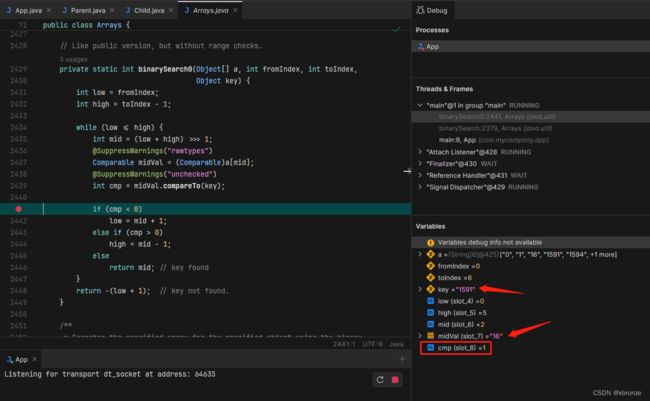【笔记】Arrays.binarySearch()实践,以及需要注意的一些问题点
背景:我想校验一个指定的String字符串,是否存在于另一个String数组中,选择Arrays.binarySearch()方法实现,代码如下:
String[] item = {"0","1","16","1591","1594","1596"};
if (Arrays.binarySearch(item, "1591") > 0) {
System.out.println("exists");
} else {
System.out.println("not exists");
}
运行结果:
not exists
很直观的能看到item数组里面存在字符串1591,为什么程序运行的结果却是找不到该元素呢?
首先来看一下源码:
/**
* Searches the specified array for the specified object using the binary
* search algorithm. The array must be sorted into ascending order
* according to the
* {@linkplain Comparable natural ordering}
* of its elements (as by the
* {@link #sort(Object[])} method) prior to making this call.
* If it is not sorted, the results are undefined.
* (If the array contains elements that are not mutually comparable (for
* example, strings and integers), it cannot be sorted according
* to the natural ordering of its elements, hence results are undefined.)
* If the array contains multiple
* elements equal to the specified object, there is no guarantee which
* one will be found.
*
* @param a the array to be searched
* @param key the value to be searched for
* @return index of the search key, if it is contained in the array;
* otherwise, (-(insertion point) - 1). The
* insertion point is defined as the point at which the
* key would be inserted into the array: the index of the first
* element greater than the key, or a.length if all
* elements in the array are less than the specified key. Note
* that this guarantees that the return value will be >= 0 if
* and only if the key is found.
* @throws ClassCastException if the search key is not comparable to the
* elements of the array.
*/
public static int binarySearch(Object[] a, Object key) {
return binarySearch0(a, 0, a.length, key);
}
注意,注释上提到了两个重点:
- 使用二分查找算法在指定数组中搜索指定对象;
- 在调用此方法之前,必须根据元素的自然顺序(如通过sort(Object[])方法)将数组按升序排序。
也就是说,数组不是遍历每一个元素,与目标值做对比,校验是否相同,而是通过二分查找算法,先找到数组中间的元素,与目标值做比较:如果目标值大于中间值,则继续比较数组后半部分的元素;如果目标值小于中间值,则继续比较数组前半部分的元素;如果等于,那么就直接返回中间元素的数组下标。因此在调用此方法之前,要先对数组进行升序排序。
private static int binarySearch0(Object[] a, int fromIndex, int toIndex,
Object key) {
int low = fromIndex;
int high = toIndex - 1;
while (low <= high) {
int mid = (low + high) >>> 1;
@SuppressWarnings("rawtypes")
Comparable midVal = (Comparable)a[mid];
@SuppressWarnings("unchecked")
int cmp = midVal.compareTo(key);
if (cmp < 0)
low = mid + 1;
else if (cmp > 0)
high = mid - 1;
else
return mid; // key found
}
return -(low + 1); // key not found.
}
源码中,是中间值通过(low + high) >>> 1 的方式获取的。
这是一个在二分查找算法中常见的代码片段。low 和 high 通常表示搜索范围的下界和上界。mid 是下界和上界的中间值,通过 (low + high) >>> 1 计算得出。
这是由于在Java中,+ 运算符对于整数是按照整数算术运算(即舍去小数点)来执行的。这可能会导致整数的溢出。例如,如果 low 是 -1000000000,而 high 是 1000000000,那么 low + high 的结果将会是 -999999999 + 1000000000,这将导致整数溢出。
而使用 >>>(无符号右移运算符)则可以避免这个问题。位运算中,右移运算符 >> 对于负数会将移位后的左侧填充部分填充为该数的符号位(即负数的话填充为1,正数的话填充为0)。而 >>> 是无符号右移运算符,无论该数是正数还是负数,都会将左侧填充部分填充为0。
所以 (low + high) >>> 1 的结果就是 low + high 的值除以2的整数部分,无论 low 和 high 的值是多少。
拿到数组的中间元素后,通过int cmp = midVal.compareTo(key)的方法比较中间元素和目标值。
compareTo() 方法按字典顺序比较两个字符串(比较基于字符串中每个字符的 Unicode 值)。
接下来回到最开始的问题中,通过调试发现,中间元素16与目标值1591比较,结果cmp=1,也就是说比较的结果居然是16大于1591。

由于比较的结果大于0,因此 mid-1,接下来会拿数组左边部分的值与目标值做对比,而16左边的几个元素不存在1591,因此最终结果是在数组中找不到与目标值一致的元素。
这是因为,16和1591都是字符串类型,而非数值类型,字符串类型通过compareTo() 方法进行比较,是比较两个字符串相应位置字符的Unicode值。
/**
* Compares two strings lexicographically.
* The comparison is based on the Unicode value of each character in
* the strings. The character sequence represented by this
* {@code String} object is compared lexicographically to the
* character sequence represented by the argument string. The result is
* a negative integer if this {@code String} object
* lexicographically precedes the argument string. The result is a
* positive integer if this {@code String} object lexicographically
* follows the argument string. The result is zero if the strings
* are equal; {@code compareTo} returns {@code 0} exactly when
* the {@link #equals(Object)} method would return {@code true}.
*
* This is the definition of lexicographic ordering. If two strings are
* different, then either they have different characters at some index
* that is a valid index for both strings, or their lengths are different,
* or both. If they have different characters at one or more index
* positions, let k be the smallest such index; then the string
* whose character at position k has the smaller value, as
* determined by using the < operator, lexicographically precedes the
* other string. In this case, {@code compareTo} returns the
* difference of the two character values at position {@code k} in
* the two string -- that is, the value:
*
* this.charAt(k)-anotherString.charAt(k)
*
* If there is no index position at which they differ, then the shorter
* string lexicographically precedes the longer string. In this case,
* {@code compareTo} returns the difference of the lengths of the
* strings -- that is, the value:
*
* this.length()-anotherString.length()
*
*
* @param anotherString the {@code String} to be compared.
* @return the value {@code 0} if the argument string is equal to
* this string; a value less than {@code 0} if this string
* is lexicographically less than the string argument; and a
* value greater than {@code 0} if this string is
* lexicographically greater than the string argument.
*/
public int compareTo(String anotherString) {
int len1 = value.length;
int len2 = anotherString.value.length;
int lim = Math.min(len1, len2);
char v1[] = value;
char v2[] = anotherString.value;
int k = 0;
while (k < lim) {
char c1 = v1[k];
char c2 = v2[k];
if (c1 != c2) {
return c1 - c2;
}
k++;
}
return len1 - len2;
}
引申:但是要注意的是,这只适用于两个字符都属于基本字母或数字的情况。如果字符包含其他字符(比如特殊字符、标点符号等),或者涉及非数字字符,那么结果可能不会如你所预期。例如,如果’A’和’中’(Unicode值为65296)进行相减,结果将会是-38321,这显然不是我们期望的结果。因此,在进行这种操作时,一定要确保字符的取值范围和你的预期相符。
至此,文章开头 1591为什么在目标数组中 {"0","1","16","1591","1594","1596"} 匹配不到的问题,原因就是如此。